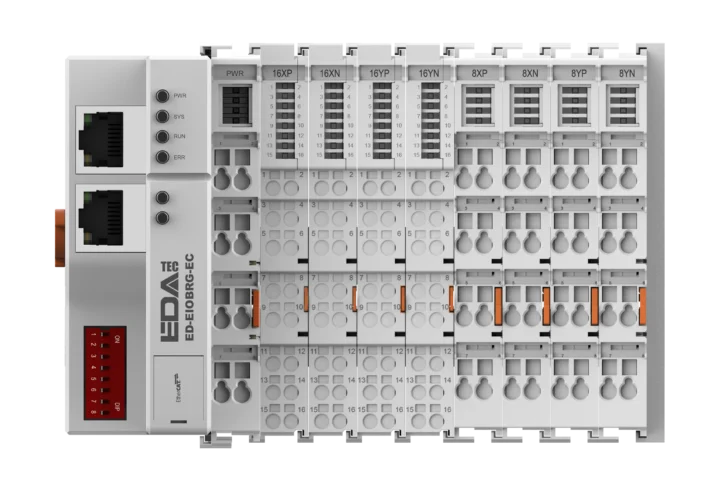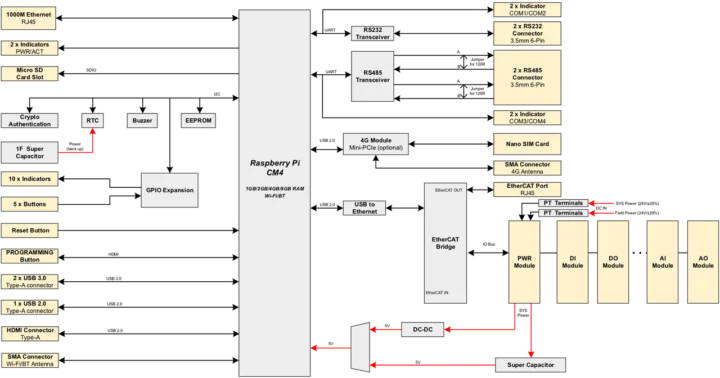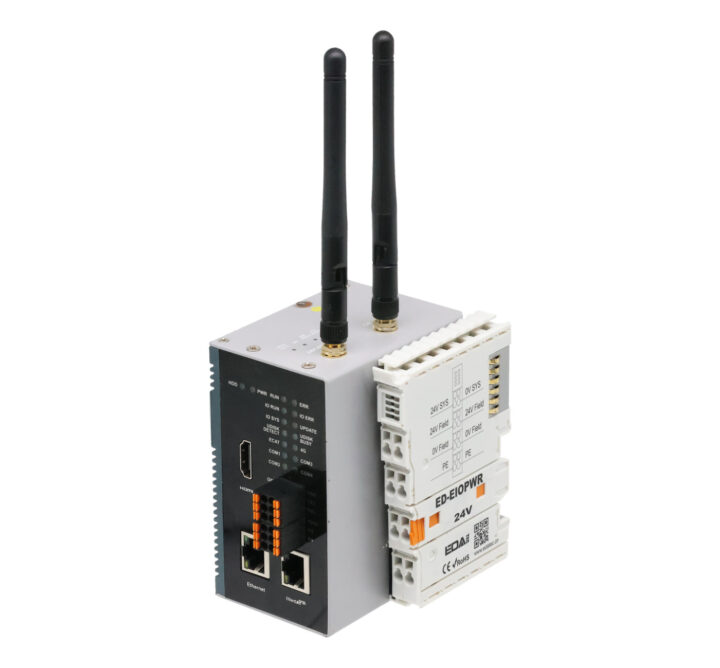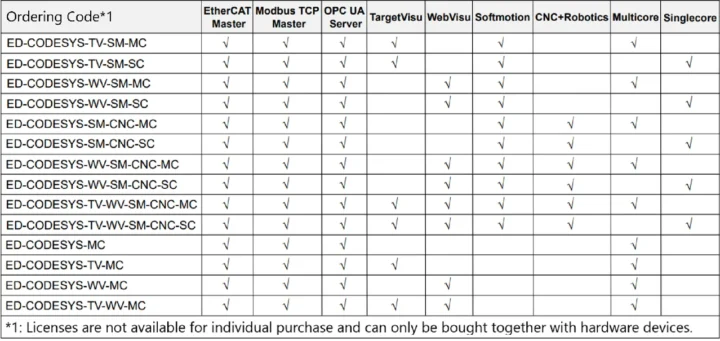EDATEC ED-PLC2010 is an industrial controller powered by a Raspberry Pi CM4, supporting EtherCAT and Modbus interfaces, up to 32 I/O modules, and preloaded with CODESYS runtime for real-time core and visualization capabilities.
DIN Rain-mountable Raspberry Pi CM4 industrial controllers are not exactly new, with products such as Modberry 500 CM4 and Edgebox-RPI4 announced shortly after the launch of the Raspberry Pi Compute Module 4 in 2020. More recently (2024), Seeed Studio introduced the reComputer R1113-10 IoT gateway, and Sfera Labs launched the Strato Pi Max. TECHBASE also upgraded the Modberry 500 with a more powerful CM5 module. EDATEC ED-PL2010 mostly differentiates itself by shipping with a licensed version of CODESYS runtime for industrial automation. It’s also possible with other vendors, but the license might need to be purchased separatly.
EDATEC ED-PLC2010 specifications:
- SoM – Raspberry Pi CM4
- SoC – Broadcom BCM2711
- CPU – Quad-core Cortex-A72 SoC @ 1.5GHz
- GPU – VideoCore VI with support for OpenGL ES 3.1 and Vulkan 1.0
- VPU
- Decode – H.265/HEVC up to 4Kp60, H.264 up to 1080p60
- Encode – H.264 up to 1080p30
- Memory – 1GB, 2GB, 4GB, or 8GB LPDDR4-3200
- Storage – 8GB, 16GB, or 32GB eMMC flash
- Optional Wireless module with WiFi 5 and Bluetooth 5.0
- SoC – Broadcom BCM2711
- Storage
- MicroSD card slot for user data
- 4KB EEPROM
- Video Output – HDMI 2.0 port up to 4Kp60
- Networking
- Gigabit Ethernet RJ45 port
- EtherCAT RJ45 port
- Up to 8x axes support
- 1x EtherCAT master, up to 128x EtherCAT slaves
- 1x Modbus TCP master, up to 63x Modbus TCP slaves
- Optional WiFi/Bluetooth (on CM4)
- Optional 4G LTE cellular mini PCIe module (EC20 or EC25 with region-specific variants)
- 2x SMA connectors for WiFi/Bluetooth and 4G antenna
- USB
- 2x USB 3.0 Type-A (5 Gbps) ports
- 1x USB 2.0 Type-A port
- Serial
- 2x RS485 via 6-pin terminal block with isolation
- 2x RS232 via 6-pin terminal block with isolation
- Expansion I/Os – Up to 32 “ED-EIO” I/O modules with type DI, DO, AI, AO, RTD, TC, and High-Speed Counter
- Security – Crypto authentication chip
- Misc
- 16x LED indicators for power, Ethercat, 4G, serial ports, system status, etc…
- Buttons for Reset, Factory Reset, IP address Reset, UDISK RM (remove USB drive safely), IMP (import PLC), STOP/START (for runtime)
- RTC with 1F SuperCAP backup (option for CR1220 battery)
- Buzzer
- Power supply
- System Power – 24V DC-in via 2-pin terminal block
- Field Power – 24V DC-in via 2-pin terminal block
- Power Consumption – Up to 24 Watts
- Dimensions – 103 x 71 x 81mm excluding antenna and DIN Rail bracket
- Weight – About 750 grams
- Temperature Range – Operating: -10 to 55°C; storage: -20 to 60°C
- Humidity – 5 to 95% RH

The company offers a long list of ED-EIO module, including digital input and output modules with 8 to 16 channels, analog input modules with 4 or 8 channels, 4-channel analog output modules, and specialized modules with EtherCAT coupler, RTD input, thermocouple input, high-speed counter, power expansion, or EtherCAT terminal cover. You’ll find the full list on the remote I/O modules page of the company’s website.
The Raspberry Pi CM4-powered industrial controller runs Raspberry Pi OS (Lite) 64-bit and is pre-loaded with a licensed version of the CODESYS Runtime with the following features:
- Multicore CODESYS Control Runtime System, with the Singlecore CODESYS Control Runtime System available as an optional add-on
- Programming Mode – IEC 61131-3 programming languages, including ST, LD, FBD, SFC, and CFC
- IDE Support – CODESYS V3.5
- Fieldbus – CODESYS EtherCAT Master and CODESYS Modbus TCP Master
- Motion Control – Optional CODESYS SoftMotion and CNC+Robotics
- Visualization – Optional CODESYS TargetVisu and CODESYS WebVisu
- Support OPC UA Server

Different CODESYS licenses are available when purchasing an ED-PLC2010 controller, depending on the features needed.
Some EDATEC ED-PLC2010 variants and ED-EIO module are listed on DigiKey, but all are currently out of stock. Check out the product page for more information and documentation such as a datasheet and a user manual to get started.


Jean-Luc started CNX Software in 2010 as a part-time endeavor, before quitting his job as a software engineering manager, and starting to write daily news, and reviews full time later in 2011.
Support CNX Software! Donate via cryptocurrencies, become a Patron on Patreon, or purchase goods on Amazon or Aliexpress






